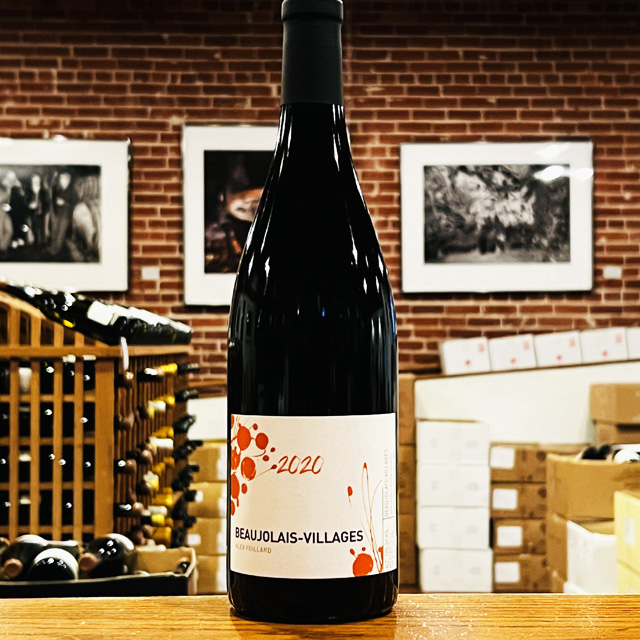Notify me
2020 Beaujolais-Villages
Alex Foillard
Alex may be young, but his wines show plenty of wisdom and depth. In fact, Alex’s Beaujolais-Villages is a sort of tightrope act, looking for that Guy Breton-esque burst of airy pleasure, mixed with a, dare I say it, Jean Foillard-like depth and grip. I was hoping to avoid adding the inevitable mention of Jean when speaking about Alex’s wines, but I just can’t help but think of this as the most compelling and delicious Beaujolais cross-pollination one could wish for.
—Chris Santini
| Wine Type: | red |
| Vintage: | 2020 |
| Bottle Size: | 750mL |
| Blend: | Gamay |
| Appellation: | Beaujolais-Villages |
| Country: | France |
| Region: | Beaujolais |
| Producer: | Alex Foillard |
| Winemaker: | Alex Foillard |
| Vineyard: | 70 years old |
| Soil: | Limestone, Sand |
| Farming: | Organic (practicing) |
| Alcohol: | 13% |
More from this Producer or Region

2022 Vin de France Blanc “Perle de Gamay”
France | Beaujolais
Notes of stones, pear, and citrus... Enjoy as a refreshing, mineral apéritif or alongside your favorite fresh seafood.

2021 Beaujolais-Villages
France | Beaujolais
This drinks like a Gamay infusion with lovely hints of potpourri, spice, and fresh grapes.

2020 Côte de Brouilly
France | Beaujolais
Alex Foillard fashions a Côte-de-Brouilly that strikes a deeper register, saturating the senses with tooth-staining fruit, gritty earth, and just a touch of the good funk.

2021 Brouilly “Reverdon”
France | Beaujolais
The 2021 vintage proved an elegant one for Thivin’s Brouilly, with all the suppleness and tonicity you’d expect from this storied estate.

2022 Fleurie
France | Beaujolais
An opulent, mouth-filling expression of granitic terroir, this bottling has the delicate floral nuances and fine-grained tannin that differentiates Fleurie from the other crus.

2022 Morgon “Vieilles Vignes”
France | Beaujolais
If Beaujolais were Burgundy, we might consider Morgon to be Vosne-Romanée, with its haunting perfume and silky texture, the proverbial iron fist in a velvet glove.

2021 Côte de Brouilly HALF BOTTLE
France | Beaujolais
Cassis, blueberry, violets, plum, and blackberry. In other words, a whole lot of Beaujolais in one bottle!

2020 Brouilly
France | Beaujolais
A generous dash of plump, sun-ripened fruit enveloping a granite core.

2015 Côte-de-Brouilly
France | Beaujolais
Nicole's thick, chewy Côte de Brouilly is a delicious and satisfying wine aging at a glacial pace.

2021 Brouilly
France | Beaujolais
A generous dash of plump, sun-ripened fruit enveloping a granite core.
About The Region
Beaujolais

After years of the region’s reputation being co-opted by mass-produced Beaujolais Nouveau and the prevalence of industrial farming, the fortunes of vignerons from the Beaujolais have been on the rise in the past couple of decades. Much of this change is due to Jules Chauvet, a prominent Beaujolais producer who Kermit worked with in the 1980s and arguably the father of the natural wine movement, who advocated not using herbicides or pesticides in vineyards, not chaptalizing, fermenting with ambient yeasts, and vinifying without SO2. Chief among Chauvet’s followers was Marcel Lapierre and his three friends, Jean Foillard, Guy Breton, and Jean-Paul Thévenet—a group of Morgon producers who Kermit dubbed “the Gang of Four.” The espousal of Chauvet’s methods led to a dramatic change in quality of wines from Beaujolais and with that an increased interest and appreciation for the AOC crus, Villages, and regular Beaujolais bottlings.
The crus of Beaujolais are interpreted through the Gamay grape and each illuminate the variety of great terroirs available in the region. Distinguishing itself from the clay and limestone of Burgundy, Beaujolais soils are predominantly decomposed granite, with pockets of blue volcanic rock. The primary vinification method is carbonic maceration, where grapes are not crushed, but instead whole clusters are placed in a tank, thus allowing fermentation to take place inside each grape berry.
Much like the easy-going and friendly nature of many Beaujolais vignerons, the wines too have a lively and easy-drinking spirit. They are versatile at table but make particularly good matches with the local pork sausages and charcuterie. Though often considered a wine that must be drunk young, many of the top crus offer great aging potential.
More from Beaujolais or France
2022 Beaujolais Blanc “Clos de Rochebonne”
Château Thivin France | Beaujolais
2021 Morgon “Vieilles Vignes”
Jean-Paul et Charly Thévenet France | Beaujolais
2021 Côte de Brouilly
Château Thivin France | Beaujolais
2022 Fleurie
Guy Breton France | Beaujolais
2022 Morgon “La Roche Pilée”
Jean-Paul et Charly Thévenet France | Beaujolais
2021 Régnié
Guy Breton France | Beaujolais
2020 Côte de Brouilly
Alex Foillard France | Beaujolais
2021 Côte de Brouilly HALF BOTTLE
Château Thivin France | Beaujolais
2021 Côte de Brouilly
Guy Breton France | Beaujolais
2021 Brouilly “Reverdon”
Château Thivin France | Beaujolais
2021 Morgon “Charmes - Infusion”
Quentin Harel France | Beaujolais
2023 Vin de France Rouge “Raisins Gaulois”
M. & C. Lapierre France | Beaujolais
2022 Beaujolais Blanc “Clos de Rochebonne”
Château Thivin France | Beaujolais
2021 Morgon “Vieilles Vignes”
Jean-Paul et Charly Thévenet France | Beaujolais
2021 Côte de Brouilly
Château Thivin France | Beaujolais
2022 Fleurie
Guy Breton France | Beaujolais
2022 Morgon “La Roche Pilée”
Jean-Paul et Charly Thévenet France | Beaujolais
2021 Régnié
Guy Breton France | Beaujolais
2020 Côte de Brouilly
Alex Foillard France | Beaujolais
2021 Côte de Brouilly HALF BOTTLE
Château Thivin France | Beaujolais
2021 Côte de Brouilly
Guy Breton France | Beaujolais
2021 Brouilly “Reverdon”
Château Thivin France | Beaujolais
2021 Morgon “Charmes - Infusion”
Quentin Harel France | Beaujolais
2023 Vin de France Rouge “Raisins Gaulois”
M. & C. Lapierre France | Beaujolais
Kermit once said...

Kermit once said...
Living wines have ups and downs just as people do, periods of glory and dog days, too. If wine did not remind me of real life, I would not care about it so much.














